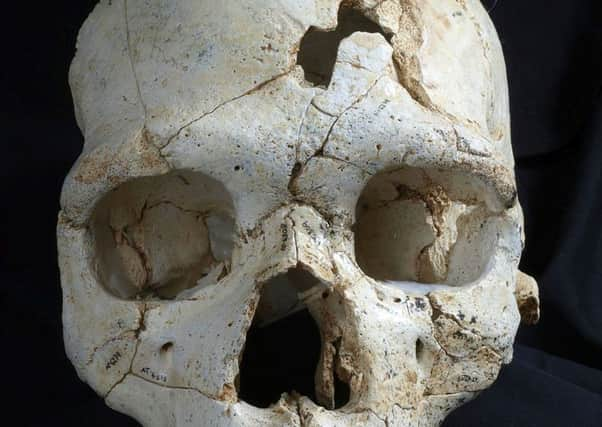Archaeologists uncover world’s first murder


Researchers say lethal wounds that have been identified on a human skull in Spain may indicate one of the first cases of murder in human history.
The archeological site, Sima de los Huesos in northern Spain, is located deep within an underground cave system and contains the skeletal remains of at least 28 people that date to around 430,000 years ago.
Advertisement
Hide AdAdvertisement
Hide AdThe only access to the site is through a 13-metre deep vertical shaft, and how the human bodies arrived there remains a mystery.
A nearly complete skull, “Cranium 17”, is comprised of 52 cranial fragments recovered during excavations at the site over the last 20 years.
Study leader Doctor Nohemi Sala said: “This skull shows two penetrating lesions on the frontal bone, above the left eye.”
Relying on modern forensic techniques, the researchers showed that both fractures were likely produced by two separate impacts by the same object, with slightly different trajectories around the time of the person’s death.
The researchers, whose findings were published in the journal Plos One, said the injuries are unlikely to be the result of an accidental fall down the vertical shaft.
Instead, the type of fracture, the location and the fact they appear to have been produced by two blows with the same object lead the researchers to interpret them as the result of an act of “lethal interpersonal aggression” – or what may constitute the earliest case of murder in human history.
Dr Sala said if the person was already dead, they were likely to be carried to the top of the vertical shaft by other humans.
The authors suggest that humans were likely responsible for the accumulation of bodies in the Sima de los Huesos.
Advertisement
Hide AdAdvertisement
Hide Ad“What makes the site unique is the extraordinary and unprecedented accumulation of hominin [humans and their ancestors] fossils there; nothing quite so big has ever been discovered for any extinct hominin species – including Neanderthals,” said Prof Juan-Luis Arsuaga from the Complutense University of Madrid, who is the lead author of a paper published in the journal Science.
Study co-author Prof Ignacio Martínez said: “This site has been excavated continuously since 1984. After thirty years, we have recovered nearly 7,000 human fossils corresponding to all skeletal regions of at least 28 individuals. This extraordinary collection includes 17 fragmentary skulls, many of which are very complete.”
The Sima de los Huesos (“Pit of Bones” in Spanish) is a lower Paleolithic site, one of several important sections of the Cueva Mayor-Cueva del Silo cave system in north-central Spain.